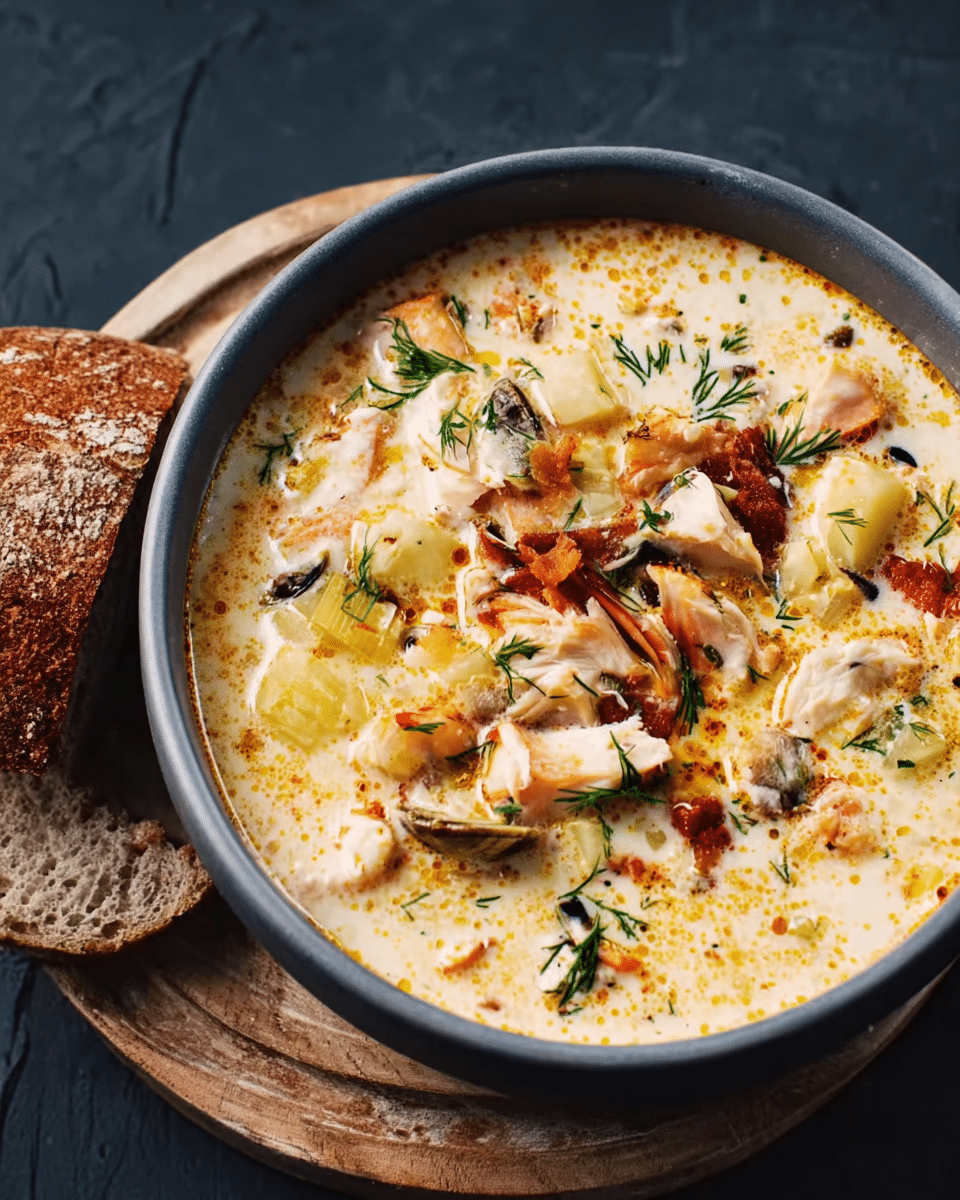This Creamy Coastal Fish Chowder is a comforting classic that captures the essence of seaside dining. Tender chunks of white fish simmer gently in a velvety broth, complemented by the earthy sweetness of potatoes and the subtle pop of corn. The combination of fresh herbs and rich cream creates a luxurious yet balanced flavor that warms you from the inside out.
Perfect for cold evenings, this chowder pairs beautifully with crusty bread or a warm baguette. Whether you’re hosting a dinner party or simply craving a taste of the ocean, this hearty bowl will transport you straight to a charming coastal kitchen, where the scent of the sea mingles with the aroma of a simmering pot.
Full Recipe:
Ingredients:
-
1 lb (450g) white fish fillets (cod, haddock, or halibut), cut into bite-sized pieces
-
1 cup (240ml) heavy cream
-
4 cups (960ml) fish stock or chicken broth
-
3 medium potatoes, peeled and diced
-
1 large onion, finely chopped
-
2 cloves garlic, minced
-
1 cup (150g) corn kernels (optional)
-
2 tbsp butter
-
2 tbsp all-purpose flour
-
1 bay leaf
-
Salt and pepper, to taste
-
Fresh parsley, chopped, for garnish
-
Optional: 1 cup (240ml) white wine for deglazing
Directions:
-
Prepare the vegetables and fish. Dice potatoes, chop onion, mince garlic, and cut fish into pieces.
-
In a large pot, melt butter over medium heat. Sauté onions and garlic until translucent. Deglaze with white wine if using.
-
Sprinkle flour over the mixture, stirring for 2 minutes to form a roux.
-
Gradually whisk in the fish stock, ensuring no lumps. Add potatoes and bay leaf, then simmer for 10–15 minutes until potatoes are tender.
-
Add fish pieces and corn (if using). Simmer gently for 5–7 minutes until fish is cooked through.
-
Stir in heavy cream, then season with salt and pepper.
-
Remove the bay leaf, garnish with parsley, and serve hot with crusty bread.
Prep Time: 15 minutes | Cooking Time: 30 minutes | Total Time: 45 minutes
Kcal: 350 kcal | Servings: 6 servings
Creamy Coastal Fish Chowder – A Comfort Dish with Maritime Roots
There’s something about fish chowder that instantly brings comfort. It’s a dish steeped in history, tied to the traditions of coastal living, and cherished by generations of fishermen, home cooks, and seafood lovers alike. A well-prepared fish chowder is more than just a soup it’s a culinary journey that transports you straight to a windswept harbor town, where fishing boats unload their daily catch and the scent of the ocean lingers in the air.
Fish chowder has its roots in fishing communities along the North Atlantic coast, particularly in New England, Canada’s Maritime Provinces, and parts of Northern Europe. In its earliest form, chowder was a practical fisherman’s stew, created to make use of the day’s catch along with whatever vegetables and seasonings were on hand. The name “chowder” is thought to come from the French word “chaudière,” meaning cauldron, a nod to the large pots used by early settlers and sailors to prepare hearty meals.
Over time, chowder evolved from a rustic necessity to a celebrated dish. While some regions favor tomato-based chowders (like Manhattan clam chowder), creamy variations such as this fish chowder remain the most iconic in many coastal towns. The creamy style is believed to have developed in the northeastern United States and Atlantic Canada, where dairy was more readily available and local tastes leaned toward richer, more indulgent flavors.
Why This Chowder Stands Out
What sets a great fish chowder apart is the careful balance of flavors and textures. The base should be velvety and rich, yet not overly heavy. The fish should be tender and flaky, holding its shape without becoming mushy. Potatoes add hearty substance, while the subtle sweetness of corn and onions brings depth and natural balance.
The use of fresh white fish such as cod, haddock, or halibut is essential. These varieties are mild in flavor but firm in texture, which means they won’t fall apart during cooking. The cream adds a luxurious mouthfeel that pairs beautifully with the delicate brininess of the seafood. The addition of fresh parsley and optional white wine elevates the flavor profile even further, making the chowder restaurant-worthy without being complicated.
Another defining quality of this particular chowder is its versatility. While it’s perfect as-is, it’s also a blank canvas for other seafood additions, like scallops, shrimp, or clams. In many coastal households, the chowder pot becomes a creative space for using whatever the fisherman’s net happens to bring in that day.
Cultural Significance and Tradition
In fishing communities, fish chowder is not just a meal it’s a tradition. It often plays a role in community gatherings, festivals, and family celebrations. In New England, chowder has been served at summer clambakes and fall harvest events for centuries. In Newfoundland and Nova Scotia, it’s a staple dish for church suppers, town socials, and even wedding receptions.
The dish also embodies the “waste not” philosophy of early settlers and fishermen. In the past, fish that wasn’t sold at the market or smaller, less marketable catches would be cooked into chowder to feed the family. Potatoes, onions, and dairy were affordable staples that stretched the meal further, ensuring nothing went to waste.
This frugality didn’t diminish the appeal of the dish in fact, it made chowder deeply tied to the idea of home, comfort, and shared meals. Even today, when ingredients are more accessible, the sense of nostalgia and heritage remains one of the main reasons people continue to make fish chowder.
Tips for Perfect Fish Chowder Every Time
While chowder is a forgiving dish, a few techniques can make the difference between good and exceptional.
-
Choose fresh fish whenever possible. Freshness is key for flavor and texture. If using frozen fish, make sure it’s fully thawed and patted dry before cooking.
-
Avoid overcooking the fish. Add fish towards the end of cooking and simmer gently until just done — this keeps it tender and moist.
-
Layer your flavors. Sautéing onions and garlic first develops a sweet aromatic base. Deglazing with white wine or a splash of stock lifts those caramelized bits into the chowder for deeper flavor.
-
Mind the consistency. Chowder should be thick enough to coat the back of a spoon but still pourable. Adjust thickness by mashing a few potatoes or adding extra stock.
-
Season at the end. Salt levels can fluctuate during cooking, so taste and adjust seasoning just before serving.
Delicious Variations to Explore
One of the charms of fish chowder is how easily it can be adapted:
-
Seafood Medley Chowder: Add shrimp, scallops, and clams alongside the fish for a more indulgent, restaurant-style dish.
-
Smoky Fish Chowder: Incorporate smoked haddock or add crispy bacon bits for a rich, smoky undertone.
-
Herb-Infused Chowder: Fresh dill or thyme can complement the fish beautifully, offering a fragrant twist.
-
Dairy-Free Chowder: Swap cream for coconut milk for a lighter, subtly tropical profile.
-
Gluten-Free Chowder: Use cornstarch or gluten-free flour as a thickener instead of all-purpose flour.
Perfect Pairings and Serving Suggestions
Fish chowder shines when paired with the right sides and accompaniments. The most traditional pairing is fresh, crusty bread ideal for dipping into the creamy broth. Oyster crackers are another classic choice, adding a crunchy texture contrast. For a more substantial meal, serve chowder alongside a crisp green salad with a tangy vinaigrette to cut through the richness.
For those who enjoy a touch of indulgence, garlic bread or cheesy biscuits work wonderfully. On the other hand, a slice of cornbread adds a slightly sweet note that complements the savory chowder.
In beverage pairings, a chilled white wine like Chardonnay or Sauvignon Blanc enhances the chowder’s creaminess without overpowering it. If you prefer beer, a light lager or pale ale pairs beautifully with the dish’s briny notes.
Storage and Reheating Advice
Like many soups and stews, fish chowder often tastes even better the next day, as the flavors have had time to meld. To store, let the chowder cool to room temperature before placing it in an airtight container in the refrigerator. It will keep well for up to three days.
When reheating, use gentle heat on the stovetop and avoid boiling, as high temperatures can cause the fish to become tough and the cream to separate. If the chowder thickens in the fridge, simply add a splash of stock or milk while warming it.
Nutritional Benefits
Beyond its comfort-food appeal, fish chowder offers genuine nutritional value. White fish varieties like cod and haddock are lean sources of high-quality protein, rich in essential vitamins like B12 and minerals such as selenium and phosphorus. They’re also a good source of omega-3 fatty acids, which are known for their heart and brain health benefits.
Potatoes contribute complex carbohydrates, potassium, and fiber, while onions and garlic bring antioxidants and immune-boosting compounds. While cream adds saturated fat and calories, it also contributes to satiety and in moderation, it’s part of a balanced diet.
Why You’ll Love Making This Dish
This chowder is the perfect blend of simplicity and sophistication. It’s approachable for beginner cooks yet impressive enough for a dinner party. It’s quick enough for a weeknight (taking under an hour from start to finish) yet comforting enough to be the centerpiece of a cozy weekend meal.
Its adaptability means you can use what you have on hand, making it both practical and waste-conscious. And because it’s rooted in centuries-old tradition, you’re not just making soup you’re carrying on a beloved culinary legacy.
Conclusion:
Creamy Coastal Fish Chowder is more than a recipe it’s a celebration of maritime tradition, comfort, and the beauty of fresh, simple ingredients. From its humble beginnings in fishermen’s pots to its place on modern dinner tables, chowder has remained a dish that warms the body and soul.
Whether enjoyed as a hearty lunch on a crisp fall day, served as a starter for a seafood feast, or prepared as a comforting remedy for winter’s chill, this dish never fails to satisfy. With its velvety texture, tender fish, and the perfect balance of flavors, fish chowder is a timeless classic that deserves a place in every home cook’s repertoire.
By making this dish, you’re not just feeding yourself or your family you’re keeping alive a rich culinary tradition that has connected generations to the sea and to each other. And in a world that moves quickly, a steaming bowl of fish chowder offers a delicious reminder to slow down, savor the moment, and enjoy the simple pleasures of good food.






